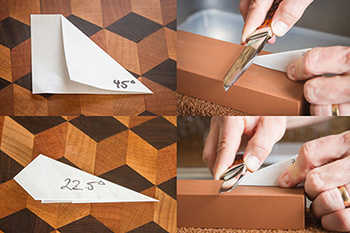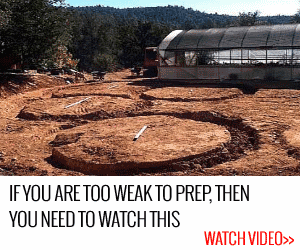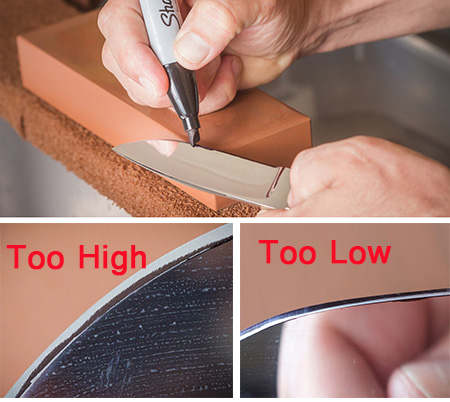| Online: | |
| Visits: | |
| Stories: |
How to Make Your Knife as Sharp as the Devil Himself
A Sharp Knife is a Safe Knife
Keeping a sharp edge on your blade is important for your own safety for two reasons:
- Compensating for a dull edge by applying additional force to finish a cut is where serious injuries can occur. If the knife blade is unexpectedly freed from what you are cutting, there is often an ongoing momentum that can slash you.
- And second because one day you might actually have to use it in a life-threatening situation. You don’t want a blunt knife.

How to Test Your Knife’s Sharpness
First of all “normal sharp” depends on the use of a tool. Normal sharp:
- For a kitchen knife – should be able to cut vegetables with almost no downward pressure;
- For a woodworking tool – the tool should cut wood fibers cleanly without leaving marks or crushing the wood fibers;
- On a fillet or skinning knife – it should be able to cut very quickly without having to saw through the meat;
- But a Survival Knife has to pass all these tests;
If you really want to test your survival knife, you have to get down to fine-tuned levels of sharpness. And here are two tests you can use.
 Take a piece of paper and hold it vertically. If you try to cut it with a dull knife, the paper will crumple beneath the knife. A sharp knife will cut it cleanly when use a slicing motion to cut through the paper. A razor sharp knife can cut the paper cleanly by just pressing down on the edge of paper without any slicing at all.
Take a piece of paper and hold it vertically. If you try to cut it with a dull knife, the paper will crumple beneath the knife. A sharp knife will cut it cleanly when use a slicing motion to cut through the paper. A razor sharp knife can cut the paper cleanly by just pressing down on the edge of paper without any slicing at all.
 Another test is to shave the hair on your arms. A dull or even moderately sharp knife will just fold over your arm hairs without cutting. A well sharpened knife will cut almost all of the hairs in one pass. A “devil” sharp knife will cut all the hairs in its path. This level of sharpness can only be attained using the finest tools. (source)
Another test is to shave the hair on your arms. A dull or even moderately sharp knife will just fold over your arm hairs without cutting. A well sharpened knife will cut almost all of the hairs in one pass. A “devil” sharp knife will cut all the hairs in its path. This level of sharpness can only be attained using the finest tools. (source)
The Angle
The first factor effecting edge sharpness is the angle it is sharpened. The lower the angle, the sharper the blade becomes. However, the lower the angle, the weaker the edge becomes.
 A 22.5° should be perfect in most cases (see picture). But when choosing the angle you may take into consideration the hardness of the steel. In traditional European kitchen cutlery is softer about 56hrc than Japanese at 61hrc and some sashimi knives in steels like ZDP-189 are around 67hrc. Most European cutlery is sharpened to an angle around 20-22.5° for an included angle of 40-45 degrees. Japanese knives – around 17° per side. (Source)
A 22.5° should be perfect in most cases (see picture). But when choosing the angle you may take into consideration the hardness of the steel. In traditional European kitchen cutlery is softer about 56hrc than Japanese at 61hrc and some sashimi knives in steels like ZDP-189 are around 67hrc. Most European cutlery is sharpened to an angle around 20-22.5° for an included angle of 40-45 degrees. Japanese knives – around 17° per side. (Source)
Removing Steel
Now it’s time to start removing some steel using a Japanese wet stone. If you don’t have one, very good options are CCKS 2-step sharpener, a normal stone or an electric device (like a drill or a stone wheel).
 When buying a water stone (must be kept 40min in water before), look for a large one, at least 2.5 inches wide by 8 inches long, and an inch in thickness. I recommend keeping two stones in your kit. One with a medium grit (around 800 or so) to perform major sharpening jobs, and one with a fine grit (at least 2,000) to tune the edge to a razor-sharp finish. (J. Kenji Lopez-Alt – Source)
When buying a water stone (must be kept 40min in water before), look for a large one, at least 2.5 inches wide by 8 inches long, and an inch in thickness. I recommend keeping two stones in your kit. One with a medium grit (around 800 or so) to perform major sharpening jobs, and one with a fine grit (at least 2,000) to tune the edge to a razor-sharp finish. (J. Kenji Lopez-Alt – Source)
All you need to do is the back and forth motion, checking your angle frequently as you sharpen, until you’ve established an edge.
Go slow at first, concentrating on keeping the same angle. This brings me to the problem of compensating for the human element. Naturally, as you’re sharpening, you’re going to rock up and down on your angle to some degree. You should try to control the wrist or the forearm rocking as much as possible to keep the angle of the blade the same as you push and pull the knife from one end of the stone to the other.
Sometimes it helps to cover the edge with permanent marker so you can see where you’re removing steel. Here you can see that you’re holding too high of an angle to match the angle already on the knife. Notice the permeant marker is removed from the edge but not the top of the secondary edge. Lower your angle slightly and check again. The opposite problem: too shallow of an angle (see picture).

Fine Tuning
 The final tool in the sharpening process is the leather. You can use a plain old leather belt. Basically you’re going to be doing the same thing barbers used to do with the razors. (Read more: 30 Lost Ways of Survival from 1880)
The final tool in the sharpening process is the leather. You can use a plain old leather belt. Basically you’re going to be doing the same thing barbers used to do with the razors. (Read more: 30 Lost Ways of Survival from 1880)
The leather polishes those little microscopic teeth off, so you end up with an edge just like glass.
The angle does not matter that much as long as you use pressure, because the leather is really slick.
Notice that you are not dragging the edge across the leather as before…that would probably cut your belt up.
Most of this article is written by Patrick Roehrman who runs MT Knives and has been making custom knives from his shop in the Ozarks of Missouri for the last several years, and first appeared on ITS Tactical.
Sharpening is 90% skill and 10% tools.
“This is one of the reasons I feel so strongly about learning to sharpen free hand. Once you’ve mastered the skills of sharpening free hand with a set of stones, you can use just about anything to sharpen a knife. If it will dull the knife, it will sharpen it in the reverse manner. If you’re relying on a machine to sharpen your knives, you’re limited by what the machine can do and by your access to the machine. However, if you have the required knowledge and sharpening skills, then you can sharpen anything, under any circumstances!” – Patrick Roehrman
Learning how to do stuff on your own is one of the most important things you can do to be prepared (and could be a way of life). Not only to save money but to become a better man. And in darker times or in time of crisis to be able to support and sustain your family without much outside aid. This is one of the things that I’ve learned from a well-known army officer vet Steve Walker, who went through some tough times. Watch his video and learn quite a few efficient and unconventional fast-tips about protecting your family in time of war or social chaos.
Source: Askaprepper.com
Do You Make These Fatal Mistakes In A Crisis?
The Only 4 Antibiotics You’ll Need when SHTF
What’s the #1 Killer In Any Crisis?
Turning Flour into Hardtack Biscuits With Over 100 Year Shelf Life
Nuclear Powers, the Rise in the Middle-East and the New Bomb







Yes, to resharpen knives a wet stone in fine and medium is most desirable. To just sharpen your knife than all other techniques are adequate. Mostly due to time and convenience considerations.
A semi-informative article serving as an infomercial to get you to click on the link to the dubious bulletproof home sales pitch.
You need friction to sharpen a knife, I think if you stabbed everybody in your Congress and that White house it would be sharp by the time you were finished
Hands down a full tang convex edge is the best. The convex edge can only be done properly by hand whereas 99.9% of grinds are machine produced. Once you use one the only other grind you will want to use occasionally is a hollow or scandi grind – IMHO. I find 1095, A2 and CPM3V the best. Most high end stainless and proprietary like INFI are overrated – once again IMHO. Lastly – You get what what pay for. Buy once, cry once (does not last long once its in your hands ).
).
My knives are so sharp if on my Journey I should encounter God, God shall be cut!
-Props to Hattori Hanzo.
Seriously though, if anyone wants some great vids on sharpening and blades/hunting in general (although he is a Barkie like myself) is virtuovice on YouTube.